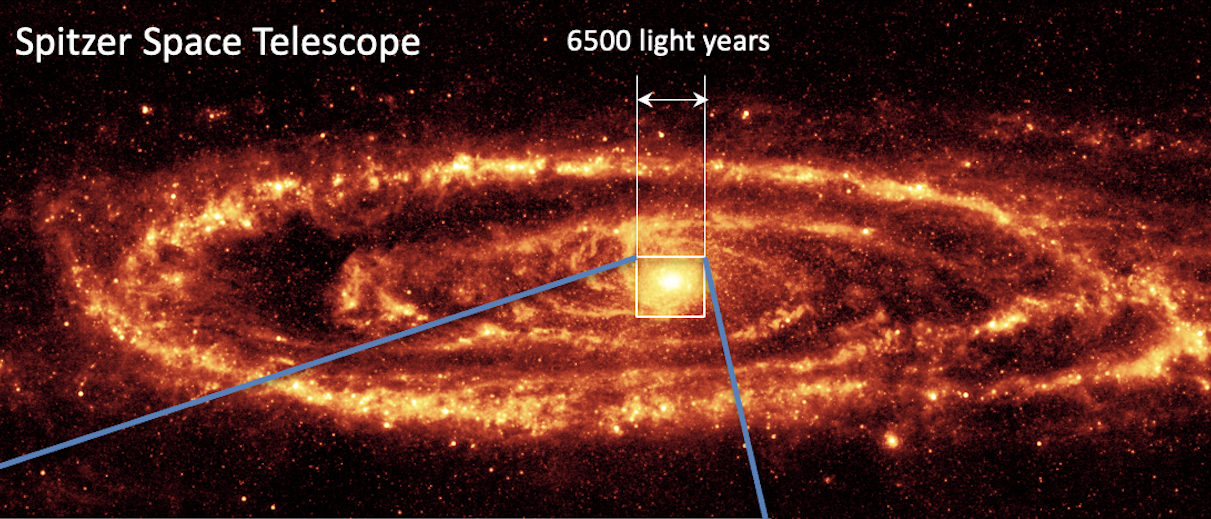
The long way needed to feed the black hole of Andromeda: from 6500 light years down to its door. The image shows the majestic of this galaxy with its many spiral arms filled with millions of stars. In the centre of the galaxy there is a supermassive black hole (small square in the image). A zoom up in this inset is bellow. It depicts long, narrow features circularising towards the centre. These are filaments of dust and gas which is being pulled into to the black hole. A further zoom of the zone (right image) shows the filaments targeting with precision the black hole location. Credit: Spitzer Space Telescope
From Partners • January 15th, 2024 • ssc2023-03 •
A team of scientists led by the Observatory of Munich University and the Instituto de Astrofísica de Canarias have obtained direct visualization of the process of feeding the supermassive black hole at the centre of the Andromeda galaxy. The study reveals the existence of long filamentary structures of gas and dust which move in a spiral starting at a distance from the black hole and ending up at the black hole itself. The results, which have been published in the Astrophysical Journal, were obtained using images from the Hubble and Spitzer space telescopes.
The Andromeda Galaxy, which is visible to the naked eye, is one of the nearest galaxies to the Milky Way. In its centre it houses a very massive black hole, which has a mass more than 100 million times that of the Sun. Even so, this black hole, as well as the one at the centre of our own galaxy called Sagittarius A* are among the least active known of the supermassive black holes at galaxy centres: they emit very little radiation.
The activity of a black hole depends on how it is being “fed”, that is to say on how the material which falls into it gets closer as it falls. It is hard to track this in the Milky Way because of our position very close to the plane of the Galaxy, where dust obscuration is very high, and the field is crowded with stars, but the situation with Andromeda is different, and we can observe the black hole with much less impediment.
Now, by combining observations from the Hubble Space Telescope and the Spitzer Space Telescoope, a team of scientists, led by the group of Computational Astrophysics from the Munich University Observatory (USM) and the Instituto de Astrofísica de Canarias (IAC) has been able to study in detail how the black hole of the Andromeda galaxy is carefully fed.
“Black holes are greedy feeders, but nevertheless sensitive” explains Christian Alig, a researcher at the USM who is the first author of the article. “When they are fed slowly and bit by bit they don’t show signs of feeding, but if the feeding is forced and excessive they react violently and aggressively.”
Filaments of material and spiral trajectories
Thanks to the two powerful space telescope the team has discovered that the black hole at the centre of Andromeda feeds by way of long filaments of dust and gas, starting some way from the centre of the galaxy. “The filaments approach the black hole little by little, and in a spiral, similarly to the way the water goes down the hole in the sink” explains Almudena Prieto, a researcher at the IAC who is a co-author of the paper.
Using powerful computers it has been possible to simulate the transport and whereabouts of this material through time and space. The image shows snapshots of the path versus time (indicated in the upper panels in units of millions of years) increasing from left to right. The network of paths, or filaments (streaks of colour in each image) appears to get more complicated as they approach the centre of the galaxy. However the motion is ordered and progressive, with the filaments rotating slowly in a spiral towards the black hole. The journey lasts for over 100 million years.
While the Hubble can see the darkening produced by the dust of the filaments in visible light, the Spitzer telescope can pick out the same filaments in the infrared. Using joint observations with the both telescopes has revealed a complete view of the accretion process of the material around the black hole. Because the Andromeda galaxy is so near, the Spitzer observations of its centre are the most detailed observations of the centre of a galaxy made with this telescope until now, and have a level of precision comparable to that achieved by the Hubble Space Telescope.
This study is part of the PARSEC project, whose aim is to investigate over a wide range of wavelengths, the nuclei of the nearest galaxies, and the accretion processes of their central black holes. Led by the IAC the project has almost 50 members in institutions in a large number of countries.
Article: C. Alig, A. Prieto et al. “The Accretion Mode in Sub-Eddington Supermassive Black Holes: Getting into the Central Parsecs of Andromeda”. 2023 ApJ 953 109. DOI: 10.3847/1538-4357/ace2c3
Contact at the IAC:
Almudena Prieto, almudena.prieto@iac.es



